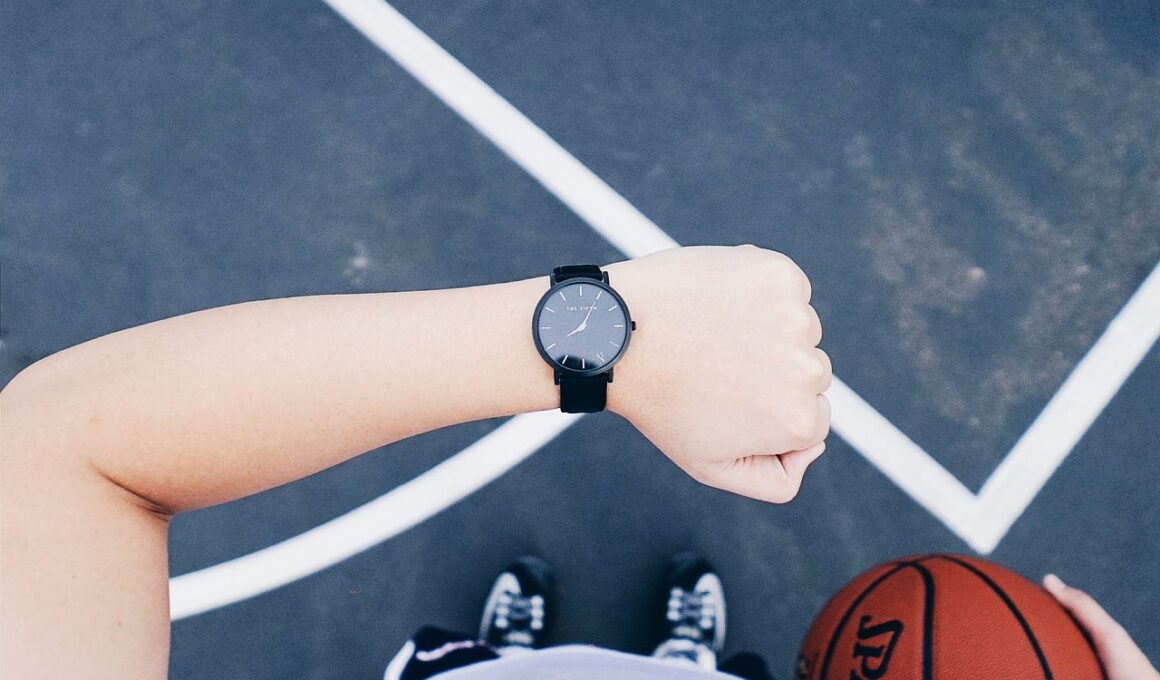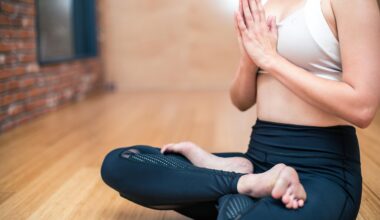Footwork Fundamentals for Successful Pick and Roll Plays
Basketball training focuses on several skills, among which footwork fundamentals are crucial for executing effective pick and roll plays. Proper footwork ensures that both the ball handler and the screener utilize their positioning to create favorable opportunities on the court. To start mastering your footwork in pick and rolls, athletes need to concentrate on three core movements: the jab step, the hop step, and the pivot. Practicing these movements enhances balance while providing options for handling defenders. Athletes should focus on maintaining low center of gravity to create more powerful movements. Try using cones to practice angles for approaching screens and cutting to exploit defensive switches. It helps if players visualize who they’re defending against, allowing better adjustments in real time. Always remember to stay on the balls of your feet. Keeping your feet action-ready grants quicker pivots and explosive direction changes. Engaging in team drills allows practicing footwork in game-like scenarios, promoting chemistry and understanding between teammates. Remember, refining footwork takes time but is vital for creating scoring opportunities during pick and rolls.
Building strength and conditioning is vital for basketball players, particularly when focusing on footwork fundamentals. Conditioning drills like ladder exercises can greatly improve agility, quick steps, and the ability to react efficiently to defensive movements. Integrating these drills into your training routine will not only aid footwork but also enhance overall athleticism. Players should aim to perform agility drills at least three times per week, targeting both foot speed and stability. Incorporating strength training, particularly focusing on the legs and core, will further amplify footwork abilities. Squats, lunges, and calf raises build crucial muscles needed for elevating performance during pick and rolls. Additionally, performing plyometric exercises boosts explosive power during cuts and jumps. Don’t forget to spend the requisite time on balance exercises. Balancing enhances control, similar to the finesse needed when utilizing footwork techniques. When combining strength workouts with agility drills, the players become more adept in detecting and exploiting defensive weaknesses. Coaches often emphasize strength training to help players withstand the physical demands of game-play, ensuring footwork translates effectively into actual plays.
Executing the Pick and Roll Effectively
When executing a pick and roll, communication between the ball handler and the screener is essential. Both players need to be aware of defensive alignment and react accordingly. The ball handler’s approach towards the screen should be aggressive, creating a level of deception that confuses the defenders. A strong first step and a proper angle toward the screen set up effective movement. For the screener, coming to a wide stance during the screen gives the ball handler room to maneuver. It’s imperative to quickly roll towards the basket after setting a pick, creating an immediate option for a pass. The angle and pace of the roll must be synchronized with the ball handler’s movement. If defenders switch, the screener should exploit the size mismatch effectively. Footwork comes into play significantly during this phase as defenses react. Make quick decisions based on defender positioning; use change of pace to keep defenders guessing. Lastly, practicing various scenarios involving guards and forwards can better simulate game conditions, allowing players to improve shared understanding with teammates.
Another integral component of footwork fundamentals is practicing proper spacing on the court. Maintaining space creates manageable driving lanes when running pick and rolls. An effective spacing technique requires understanding one’s positioning concerning teammates and opponents. When setting up, both players must ensure they are not crowding each other, as this gives defenders opportunities to recover. Athletes should invest time in fundamental spacing drills to become accustomed to how far apart they should be in various situations. The idea is to ensure both players can maneuver freely while minimizing the defenders’ ability to switch on screens. Use drills that focus on movement in tandem, adjusting distances while keeping an eye on defensive alignments. Spacing also feeds into footwork proficiency, as it forces players to adapt their movement patterns based on their positions. A well-executed pick and roll relies heavily on footwork and spatial awareness, allowing for efficient options toward the basket. Players continuously refining these skills will undoubtedly improve their overall effectiveness and elevate the team’s performance.
Analyzing Defensive Reactions
Defense’s strategy against pick and rolls varies; thus, understanding their reactions is crucial for footwork adaptation. There are several defensive approaches, from switching to hedging and trapping. Athletes must recognize these shifts and adapt their footwork accordingly. For instance, if defenders switch roles, it requires immediate adjustment in footwork by exploiting mismatches in size or speed. Practicing reaction drills such as shadowing can improve players’ anticipation skills when defenders try to intercept or disrupt plays. Recognizing signs of hedging requires an agile response; players should learn to freeze their footwork momentarily and make quick decisions to exploit openings created by defensive movements. Awareness of defensive positioning can enhance decision-making at critical moments, leading to a more fluid offensive strategy. By analyzing game film, players become recognizable in spotting defensive setups and can tailor their footwork accordingly. Sustaining efficiency in executing footwork can result in successful outcomes, making it vital for players to stay vigilant. Emphasizing adaptability in footwork translates into creating scoring chances during real-time pick and rolls.
The role of visualization in improving footwork and basketball skills cannot be underestimated. Athletes can enhance their mental imagery skills by visualizing various game scenarios. Imagine executing a pick and roll perfectly, focusing on every detail from the footwork to the angles involved. Engaging in such mental rehearsals can augment muscle memory, making movements almost instinctive. When players can mentally simulate the timing of their movements, their on-court performances often enhance significantly. This psychological preparation fosters confidence while allowing for quicker reactions in the heat of competition. Effective visualization involves spending some quiet time visualizing specific techniques and footwork routines, contributing positively to overall skill development. Ensure to focus visualizations not only on the successful execution of plays but also the how-to for overcoming obstacles. Directing attention on solutions rather than issues paves the way for robust skill enhancement. Overall, imagining the application of footwork fundamentals keeps players sharp and enables them to adapt more swiftly during actual gameplay, honing their anticipation and reaction skills. Players integrating visualization into practice routines can elevate their game and improve footwork adaptability.
Incorporating Team Drills
Team drills focusing on footwork fundamentals can significantly enhance overall execution during pick and roll plays. Incorporating situations where players routinely engage in pick and rolls promotes familiarity and teamwork. Start with stationary drills to perfect the individual footwork of each player involved in the pick and roll, adjusting their techniques for seamless execution. Use cones to set up drill scenarios, allowing players to practice approaching screens effectively, making cuts, and rolling towards the basket properly. Over time, add variations for defenders to simulate real-time adjustments, including different coverage styles. Such variations teach players how to react and maintain their footwork skills in dynamic scenarios. Regularly practicing these team drills while providing feedback strengthens shared understanding and cohesion among teammates. As players become more confident in their footwork, they will be better prepared to make quick decisions during actual games. Coaches must assess how players read each other’s body language while utilizing footwork to better react to defenders. This synergy ultimately leads to improved performance, making teamwork vital in executing successful pick and roll strategies.
In conclusion, honing footwork fundamentals is essential for mastering basketball skills and executing effective pick and roll plays. Developing strong footwork involves a combination of strength, agility, spatial understanding, and mental visualization. By focusing on these aspects, athletes can increase their effectiveness during training and games. Consistent practice combining individual, partner, and team drills allows players to refine footwork skills. Remember, improvement requires persistence; so always aim to dedicate ample time to footwork development. Coaches play a significant role in implementing training strategies to emphasize footwork fundamentals and aid players in recognizing defensive reactions. They can facilitate drills that cater to individual strengths and weaknesses, optimizing players’ responses during games. Understanding specific footwork techniques equips athletes to create scoring chances while efficiently navigating the court. By enhancing footwork, players create opportunities not just for themselves, but also for teammates. Ultimately, a well-executed pick and roll can be a game-changing tactic; thus, every player must commit to refining their footwork, ensuring successful implementation on the court during high-pressure situations.


